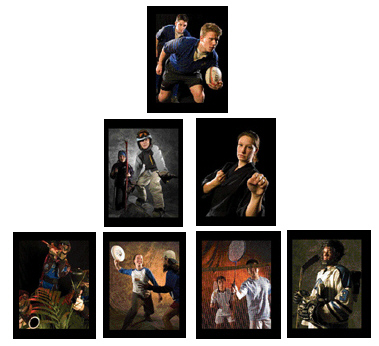






 |
||||
 |
 |
 |
 |
 |
 |
||||
|
Join the Club!
 Not everyone can — or wants to — play varsity sports, but there are lots of aspiring athletes at Hopkins. That's why about 1,500 Homewood students play club sports instead. And with 27 clubs to chose from, there are plenty of opportunities to get in the game. Here's just a sampling.
By Kay Downer, A&S
'04
All Guts, No Glory
Let It Snow
Club members cover a range of skill levels, which means beginners can pick each other up off the bunny slopes while the pros whiz down the black diamonds. And since skiing and snowboarding don't have intercollegiate competitions, snow club right now is strictly about hanging out and having fun. "Unexpectedly, a lot of people who you really would never see on campus socializing were just like, 'Do you want to hit this trail together?'" says co-president Nino Torres. The club may be getting a little more serious — they are thinking about organizing teams next year to compete in regional downhill races for skiers and half-pipe and style competitions for snowboarders. And for those who still just want to have fun, one resort hosts a 24-hour contest to see which team has the most people still on their feet at the end.
Good Form
Founded by Jay Lester, A&S '93, the Taekwondo Club — which is different from the Olympic Taekwondo Club at Hopkins — trains both for point sparring and International Taekwondo Federation competition. They practice daily and, twice a semester, train with a Grandmaster in New York. The traveling team competes in tournaments at Yale, Princeton, Columbia, and the University of Pennsylvania. This year, in the Collegiate Nationals sparring competition, they brought home one gold, one silver, and three bronzes.
Color Me "Out"
The paintball club competes regionally, and at the National Collegiate Paintball Association Championships in Orlando, Florida, in April it placed 25th out of 45 teams. Ultimate Fun
And that's just the women's team! Ultimate players take no prisoners when it comes to a sport that the rest of us think of as a sunny-afternoon-at-the-beach kind of thing. But as hard-core as they are on the field, the women's ultimate team members have a softer side. "People tend to be pretty good friends," says co-captain Holly Martin. They organize parties, have Thanksgiving dinner together, and trade gifts at Christmastime. This camaraderie spreads to the field, where games are self-refereed and, after the game, each team cheers its opponent. This year the team played locally against Towson University and traveled to tournaments in Pennsylvania and Delaware. Watch the Birdie
The scoring in badminton is similar to volleyball's (only the serving team can win a point), as is the basic idea: to hit the birdie where your opponent can't get it. If he's near the net, you "clear" — that is, "hit the birdie high and to the back," explains Lin. If he's in back, you "drop," or "tap the birdie lightly so it drops just over the net." Founded by Swee Yang Lim, A&S '03, the club is made up mostly of Asian graduate students (the game is bigger in Eastern countries than here in the States), but there's a handful of undergraduates, and the team would like to have more. "Anyone who's interested can play," says Lin. No pressure.
Cold Play
Founded by Andy Gray, A&S '88, the team has about 30 members who practice twice a week at Mt. Pleasant Ice Arena. They compete as part of the Mason-Dixon Collegiate Hockey Association and have a longstanding rivalry against Loyola, drawing about 150 fans to this year's game. "We joke that other than men's lacrosse, we're the most watched team on campus," says club president Michael Rozsa. And there are even some women getting a taste for the sport — sophomore Jina Youn is trying to organize a team. But ice hockey is expensive, with ice time costing as much as $200 an hour. So the women will have to do a little fund-raising before lacing up their skates. |
 |
|
 The Johns Hopkins Magazine |
901 S. Bond St. | Suite 540 |
Baltimore, MD 21231
The Johns Hopkins Magazine |
901 S. Bond St. | Suite 540 |
Baltimore, MD 21231Phone 443-287-9900 | Fax 443-287-9898 | E-mail jhmagazine@jhu.edu |
|